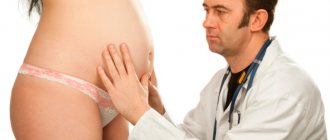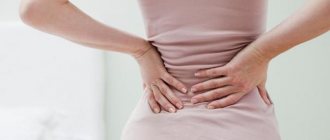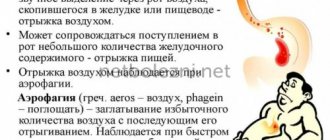The birth of a child is joy, happiness and at the same time a lot of anxiety. This distinguishes parents of first-born children. And then - as in the joke about the 5th child. If the dog did not have time to follow the toddler to his bowl, then this is his problem. Belching refers to the physiological reactions of the body. But what is the scale of this phenomenon, how often does it occur and whether it is a pathology - such thoughts swirl in the heads of young parents. Why does burping occur in newborns?
Belching - the mechanism of the process
Belching in a baby activates the process of digesting food.
Belching is a physiological process in which excess air is expelled from the stomach through the oral cavity. This requires a reflex contraction of the gastric muscles and an open cardiac sphincter. A person becomes familiar with this phenomenon in infancy.
During feeding, the baby swallows some air. It needs to be removed from their little tummy. But a small amount of air is necessary for the normal functioning of the gastrointestinal tract. This helps regulate internal pressure in the body. Additional functions of burping:
- Improving gastric motility
- Activates the process of food digestion
- Reduced pressure in the stomach
- A safe mechanism that prevents stretching of the walls of the stomach and intestines
During normal functioning of the gastrointestinal tract, the process of removing air goes unnoticed. But in pathological processes, additional symptoms are added to belching. In this case, additional examination and treatment of the underlying disease is required.
Diagnosis of gastroesophageal reflux disease
The doctor will do a physical examination of your child, review your medical history, and perform other tests, which may include:
- Chest X-ray. An x-ray can check whether the contents of the stomach are moving into the lungs. This is called aspiration.
- Examination of the upper digestive tract using Barium. The specialist checks the esophagus, stomach and duodenum. The child is given a drink of barium, which coats the organs so they can be seen on an x-ray. After this, X-ray images will show the presence of warning signs: sores, ulcers or abnormal blockages.
- Endoscopy. This test allows you to examine the organs of the digestive tract from the inside. For this, a small flexible tube is used - an endoscope with illumination and a camera at the end. During the procedure, tissue samples may also be taken for later testing.
- Esophageal manometry. This test checks the strength of the esophageal muscles and allows you to see if your baby has problems with reflux or swallowing. A small tube is inserted into the baby's nostril and then lowered down the throat into the esophagus, where it measures the resting pressure of the esophageal muscles.
- pH monitoring. This test checks the pH, or acid, level in the esophagus. A thin, plastic plug is placed into the baby's nostril and then through the larynx into the esophagus. The tube has a sensor that measures the pH level. The other end of the tube, outside the baby's body, is attached to a small monitor that records the baby's pH levels over a 24-48 hour period. During this time, the child can return home and carry out his normal activities. Parents will need to keep a diary of symptoms the baby is experiencing that may be related to reflux. These include gagging or coughing.
- Gastric emptying study. This test is done to see if the baby's stomach is emptying contents into the small intestine properly. Delayed gastric emptying can also cause esophageal reflux.
Belching in toddlers, which provokes a reaction
Belching occurs due to swallowing air while eating.
The normal amount of regurgitation in a toddler is 10 to 15 times a day. A larger number indicates the development of a pathological process. Additional factors that provoke belching:
- Increased activity during feeding or after eating.
- Tight swaddling, rompers or panties.
- Binge eating.
- Violation of feeding technique.
- Aerophagia is the swallowing of air while eating.
- Wrong combination when introducing complementary foods. For example, fruit puree after a cutlet.
- Dad or mom are smokers. The toddler inhales nicotine vapor. This helps weaken the stomach and sphincter muscles.
What Causes Gastroesophageal Reflux Disease
GERD is often caused by something that affects the lower esophageal sphincter.
The sphincter opens to let food into the stomach and closes to keep it inside. When the sphincter relaxes too often or for too long, stomach acid leaks back into the esophagus. This causes vomiting or heartburn. Everyone experiences reflux from time to time. If you've ever burped and had a sour taste in your mouth, it's reflux. Often all this means is an unpleasant taste in the mouth or a short-term mild feeling of heartburn.
Some foods affect the tone of the esophageal muscles:
- chocolate
- peppermint
- high fat foods
Other foods reduce stomach acid production:
- citrus
- tomatoes and tomato sauces
There are other causes that can lead to GERD:
- obesity
- taking medications, including some antihistamines, antidepressants, and pain relievers
- tobacco smoke A child is also at greater risk of GERD if he has:
- Down syndrome
- neuromuscular disorders such as muscular dystrophy and cerebral palsy
Belching in toddlers, general recommendations
The introduction of complementary foods should only be done on the recommendation of a pediatrician.
If belching does not cause concern in the baby, then just be patient. In newborns, the nervous system is not yet fully developed. Therefore, the likelihood of food moving back through the esophagus is high. As you grow, the frequency of regurgitation decreases. Options to solve the problem:
- Normalization of feeding. Some mothers think that the little one is malnourished. Especially if the baby is restless or requires increased attention. The baby will regurgitate excess milk - this is a physiological mechanism of protection against overeating. If the toddler is gaining weight according to age norms, then you should not increase his diet.
- Clothing – tight swaddling is now a thing of the past. Choose loose, comfortable clothes that do not put pressure on your tummy.
- Complementary foods are introduced according to the pediatrician's recommendations. Introduce any new dish gradually, starting with small quantities. Carefully observe your baby's behavior after introducing him to new food. If any alarming symptoms appear, then you will have to wait a while with this dish. This does not mean giving up completely. Just set it aside and try again after a while.
- Smoking is a bad habit. You should generally forget about cigarettes in the room where the baby is. In addition to problems with belching, the toddler runs the risk of problems with the respiratory system and other vital systems.
Aerophagia - causes and solutions to the problem
To prevent aerophagia, you need to monitor feeding techniques.
Swallowing air is common during feeding. The reasons for excess air ingress are as follows:
- The baby is worried and sucks greedily. At the same time, he opens his mouth wide. The reason may be a lack of milk from the mother or its complete absence.
- Mistakes during feeding. This happens with both breastfeeding and artificial feeding.
- Muscle weakness in a toddler due to problems during childbirth.
Prevention of aerophagia:
When should you start worrying?
The baby's belching should stop before 7 months.
Up to 7 months – belching is considered normal for toddlers. By six months the number of episodes begins to decline. But there are situations when belching indicates pathological processes in the body. Signs of pathology:
- The baby begins to lose weight or does not gain it, and refuses to eat.
- Belching turns into vomiting. Green vomit is particularly dangerous due to the ingress of bile.
- Vomiting that is independent of food intake.
- The occurrence of spasmodic pain during belching.
- The toddler begins to cry, cough or gag during and after the air leaves the stomach.
- Belching with a putrid, pungent or unpleasant odor.
- Belching with traces of blood.
- Increased body temperature.
- Stopping the processes of urination and defecation.
Parents will not be able to solve this problem on their own. Be sure to consult a doctor if these symptoms appear.
Prevention
The basis for preventing the occurrence of an unpleasant symptom is proper feeding, carried out on time. If the baby does not cry before eating, it means that air ingress will be minimized.
Tummy massage
Before eating, place the baby on his tummy 30 minutes before eating. The action allows the accumulated gases to escape and not provoke bloating. Light stroking without pressure will help. The massage is performed using a warm towel. Dry heat helps the intestinal tract relax and allow air to escape easily through the anus.
Body position
The cause of burping is often due to improper positioning of the body during feeding. To prevent air accumulation, the baby should eat while in a semi-sitting position.
Positive points if the body is positioned correctly:
- The nutrient fluid does not linger in the esophagus and immediately enters the stomach.
- The incoming air does not accumulate at the bottom, but immediately exits upward.
- The air escapes much easier.
- The bottle with artificial formula is positioned vertically in relation to the baby, there is no air in the nipple.
Mixtures
A properly selected mixture will help normal digestion of food. There will be no disturbances or accompanying symptoms. If there is additional food in the diet, the moment of belching is discussed with the doctor.
Amount of food
Belching can occur from overeating. It is worth reducing the amount of food while increasing the frequency of meals. This will allow the stomach to cope with the incoming food and be free to accept the next portion. Absorption will be better, and belching will no longer bother both the baby and the parents.
Probable Causes
Food intoxication can lead to pathological belching.
Doctors identify several probable causes for the development of pathological belching. All diseases require the attention of a doctor and careful treatment. Belching as a sign of disease:
- Hydrocephalus is the accumulation of fluid in the structures of the brain. It can be congenital or acquired. The first is a consequence of some viral diseases suffered by the mother while waiting for the toddler. The second is a consequence of a difficult birth, head injury, meningitis at an early age.
- Perinatal encephalopathy is a pathological process in the brain of a toddler that develops in 1 month of life. There can be a lot of reasons. These include maternal illnesses, unfavorable working conditions, stress, infections, childbirth before the age of 18, Rhesus conflict, and pathological childbirth. Each case is individual.
- Achalasia is a disorder of motor activity of the esophagus. Although this disorder belongs to gastrointestinal diseases, it is, in fact, a neurological disorder. The reasons for the development of this pathology are unknown.
- Pyloric stenosis is a congenital pathology of the pylorus of the stomach. Boys get sick more often than girls. Acquired forms are extremely rare as a result of a previous stomach ulcer. Doctors identify the following possible causes of the disease: the effect of certain medications, exposure to toxic reagents in early pregnancy, and endocrinological disorders. The result may be intestinal obstruction.
- Food intoxication.
- Infectious diseases.
- In rare cases of kidney disease.
All these pathological conditions require the attention of a doctor. Self-treatment in this case is not only inappropriate, but also dangerous. In difficult cases, surgery will be required. But only after consultation with a gastroenterologist, surgeon and based on the results of a thorough study.
Parents! Don't panic! Surgical actions for pyloric stenosis and achalasia are carried out according to methods proven over the years. Usually it is allowed to start feeding a toddler already on the 1st day after the intervention. In order to reduce the risk of developing pathologies, the expectant mother should undergo all the necessary tests and behave according to the recommendations of the gynecologist. If additional symptoms appear, do not self-medicate. Show your little one to the doctor! It's better to be safe than to bite your elbows later!
Pathological regurgitation
If a child spits up often and in large quantities, and not only after feedings, but also during daytime and night sleep, one may suspect the presence of health problems. If it seems to you that regurgitation occurs too often and even at night, watch the child, or better yet, record for several days how often (time of regurgitation) and approximately in what volume they occur. This will help the pediatrician give an answer during the next examination whether it is worth worrying and start undergoing examinations. For example, the following causes of regurgitation can be identified.
Malformation of the digestive organs.
As a rule, these defects are detected in the maternity hospital. We can talk about violations of the patency of the esophagus and stomach. With such defects, regurgitation occurs profusely and often, sometimes repeatedly after one meal.
Food allergies.
An allergy to cow's milk protein is quite common - in this case, after consulting a doctor, a bottle-fed child is transferred to formulas with highly hydrolyzed protein.
The mother of a breastfed child has her diet adjusted to the exclusion of cow's milk proteins.
Gastroesophageal reflux disease.
This disease is suspected when regurgitation occurs frequently and in large volumes, day and night, does not decrease by 6 months and does not go away after a year.










